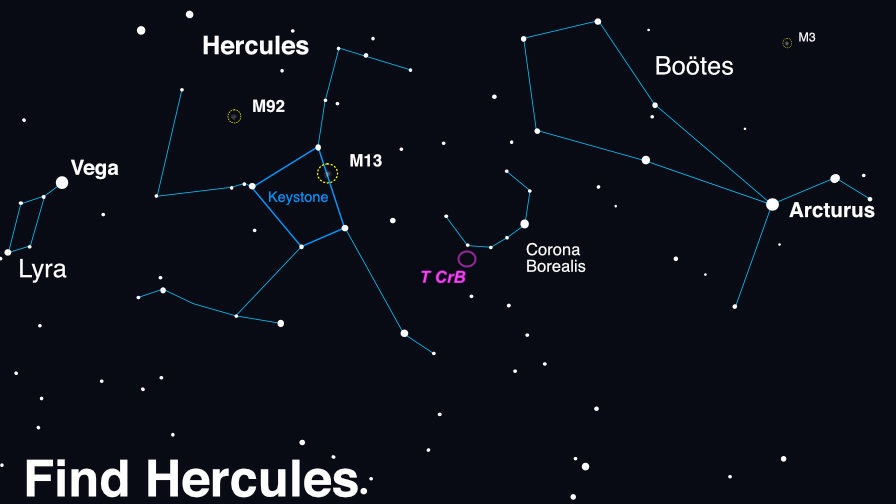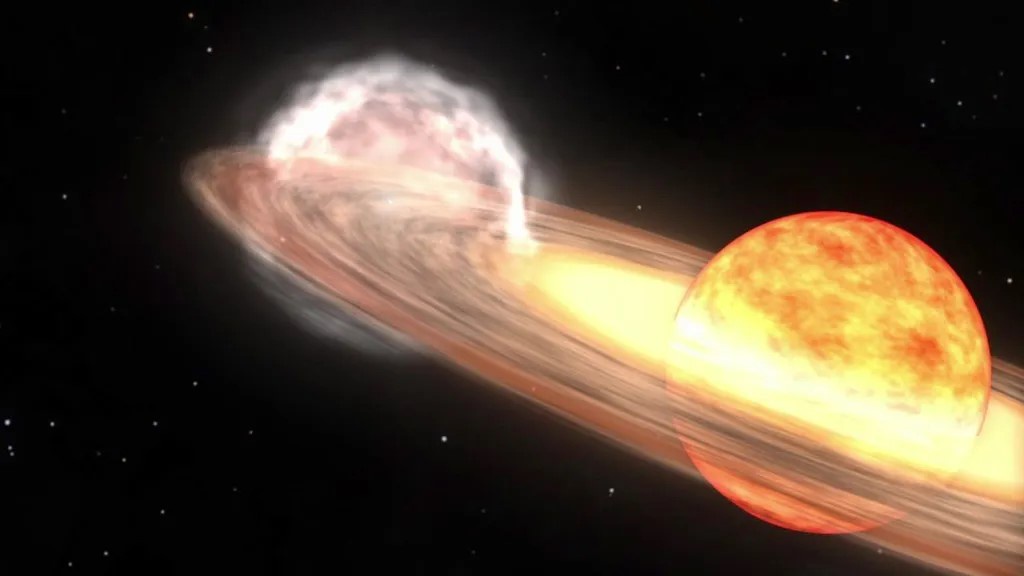High in the summer sky, the constellation Hercules acts as a centerpiece for late-night stargazers. At the center of Hercules is the “Keystone,” a near-perfect square shape between the bright stars Vega and Arcturus that is easy to recognize and can serve as a guidepost for some amazing sights. While not the brightest stars, the shape of the hero’s torso, like a smaller Orion, is nearly directly overhead after sunset. Along the edge of this square, you can find a most magnificent jewel – the Great Globular Cluster of Hercules, also known as Messier 13.
Look up after sunset during summer months to find Hercules! Scan between Vega and Arcturus, near the distinct pattern of Corona Borealis. Once you find its stars, use binoculars or a telescope to hunt down the globular clusters M13 (and a smaller globular cluster M92). If you enjoy your views of these globular clusters, you’re in luck – look for another great globular, M3, in the nearby constellation of Boötes. Image created with assistance from Stellarium: stellarium.org
Globular clusters are a tight ball of very old stars, closer together than stars near us. These clusters orbit the center of our Milky Way like tight swarms of bees. One of the most famous short stories, Nightfall by Isaac Asimov, imagines a civilization living on a planet within one of these star clusters. They are surrounded by so many stars so near that it is always daytime except for once every millennium, when a special alignment (including a solar eclipse) occurs, plunging their planet into darkness momentarily. The sudden night reveals so many stars that it drives the inhabitants mad.
Back here on our home planet Earth, we are lucky enough to experience skies full of stars, a beautiful Moon, and regular eclipses. On a clear night this summer, take time to look up into the Keystone of Hercules and follow this sky chart to the Great Globular Cluster of Hercules. A pair of binoculars will show a faint, fuzzy patch, while a small telescope will resolve some of the stars in this globular cluster.
A red giant star and white dwarf orbit each other in this animation of a nova similar to T Coronae Borealis. The red giant is a large sphere in shades of red, orange, and white, with the side facing the white dwarf the lightest shades. The white dwarf is hidden in a bright glow of white and yellows, which represent an accretion disk around the star. A stream of material, shown as a diffuse cloud of red, flows from the red giant to the white dwarf. When the red giant moves behind the white dwarf, a nova explosion on the white dwarf ignites, creating a ball of ejected nova material shown in pale orange. After the fog of material clears, a small white spot remains, indicating that the white dwarf has survived the explosion. NASA/Goddard Space Flight Center
Bonus! Between Hercules and the ice-cream-cone-shaped Boötes constellation, you’ll find the small constellation Corona Borealis, shaped like the letter “C.” Astronomers around the world are watching T Coronae Borealis, also known as the “Blaze Star” in this constellation closely because it is predicted to go nova sometime this summer. There are only 5 known nova stars in the whole galaxy. It is a rare observable event and you can take part in the fun! The Astronomical League has issued a Special Observing Challenge that anyone can participate in. Just make a sketch of the constellation now (you won’t be able to see the nova) and then make another sketch once it goes nova.
Tune into our mid-month article on the Night Sky Network page, as we prepare for the Perseids! Keep looking up!
This article is distributed by NASA’s Night Sky Network (NSN).
The NSN program supports astronomy clubs across the USA dedicated to astronomy outreach. Visit nightsky.jpl.nasa.gov to find local clubs, events, and more!



